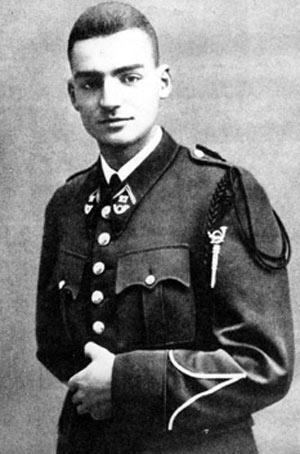Théodose Morel

Théodose "Tom" Morel
Théodose Morel was born on 1 August 1915 in Lyon. His father came from a long line of silk manufacturers from Lyon while his mother descended from officers and lawyers from Savoy.
After receiving his primary and secondary schooling from Jesuit Fathers, he chose to follow a career in arms and prepared, from 1933 to 1935, the competitive entrance exam for the Special Military School (ESM) in Saint-Cyr at Sainte Geneviève School in Versailles. Admitted into the ESM in 1935 (Lyautey year), his results two years’ later allowed him to choose his posting: the 27th Battalion of Alpine Hunters (27th BCA), in Annecy, where he arrived on 1 October 1937, the day of his appointment to the rank of sub-lieutenant.
Trained as a scout/skier in Chamonix, Théodose Morel, who married Marie-Germaine Lamy in November 1938, became an officer and assistant to the commander of the scouts/skier section in Abondance before being promoted to this post himself. In May 1939, his section took Savoy and the Italian border. It was stationed above Val d'Isère. On 21 September he was promoted to the grade of lieutenant and then the 27th BCA left for the Eastern Front, his section, to his great regret, staying behind to defend the borders.
He nonetheless managed to make a difference between 12 and 20 June when faced with Italian Alpine troops; thanks to a smart but risky manoeuvre, he and another hunter managed to take four prisoners during a reconnaissance operation.
Shot in the right arm on 18 June, he continued to support his hunters and consequently was awarded the Military Cross. On 21 and 22 June 1940, called to reinforce his section near Petit Saint-Bernard Pass, he managed to locate the enemy troops which allowed the artillery to launch defensive fire forcing the enemy to retreat. Lieutenant Morel received a second commendation and the Legion of Honour Cross.
He subsequently served in the Armistice Army in Annecy where Commander Vallette d'Osia took command of the 27th BCA while preparing his unit for attack.
In August 1941, Lieutenant Morel was appointed to the post of instructor in Saint-Cyr, transferred to Aix-en-Provence, and it was driven by this spirit of combat that he directed and instructed his students. After the invasion of the southern zone by the Germans in November 1942 and the demobilisation of the Armistice Army, he joined the Haute-Savoie resistance movement and took part in covert operations working undercover at a weaving company. Teaming up with Vallette d'Osia, commander of the Secret Army (AS) of the département, and Captain Anjot of the 27th BCA, he endeavoured to set up the AS for Haute-Savoie, inadvertently helped by the introduction of the Compulsory Work Service (STO) in February 1943. Following Vallette d'Osia’s arrest in September 1943 by the Germans, who had replaced the Italians, then his escape to England, the AS of Haute-Savoie lost its leader. He was replaced by Henri Romans-Petit, chief of the AS of Ain. Morel doubled the army’s activity, while his family narrowly escaped arrest.
By late January 1944, Lieutenant Théodose Morel, alias Tom, received the order from Henri Romans-Petit, commander of the Maquis in Haute-Savoie and the mission, to receive the parachute drops on the plateau in Les Glières at 1,500 metres altitude and 15 kilometres from Annecy. The resistance and sabotage actions were intensified and martial law was declared in the département. Tom then decided to unite 120 resistance fighters in Les Glières. Two companies were formed. From February, over six weeks, the number of clashes multiplied with the Gardes Mobiles de Réserve (mobile reserve groups) surrounding the plateau on which they were stationed. At the end of February, over 300 men formed three companies.
Using the resources at his disposal, Tom energetically organised the defence of the site in Les Glières and instructed his battalion to establish a strong and homogenous unit to fight for liberation. Under his command, the battalion – which adopted the motto vivre libre ou mourir (live free or die) – regrouped battalions from the AS (Secret Army) but also from the Franc-Tireurs et Partisans (literally ‘free shooters and partisans’) and several dozen Spanish Republicans, effectively merging different branches of the Savoy resistance movement.
A first parachute drop of 54 containers supplied the fighters with small arms. On 2 March, he decided to lead an operation against the Hôtel Beau Séjour in Saint Jean de Sixt, where members of the GMR were stationed. Thirty GMR soldiers were captured, a bargaining chip to negotiate the release of Michel Fournier, a student of medicine and nurse for the maquis, arrested in Grand Bornand a few days earlier. But despite the gentlemen’s agreement made with the police intendant Lelong from Annecy, Fournier remained imprisoned.
On 5 March, a second parachute drop was made on Les Glières, supplying 30 containers. To force Lelong into keeping his promise and after receiving precise information, Tom decided to lead, on the night of 9 March 1944, an important operation against the GMR's headquarters based in Entremont, for which he rallied together some 100 men. He saved himself for the main objective: the attack on the Hôtel de France, the headquarters of the police staff. The scouts/skiers section succeeded in penetrating the building following a fierce battle.
At the moment the hunters released their prisoners, Commander Lefèvre, head of the GMR, took out a concealed weapon from his pocket and cowardly shot Tom Morel who fell, hit in the heart, before being killed himself.
Lieutenant Théodose Morel was buried by his comrades, on Plateau des Glières, on 13 March. On 2 May 1944, his body was brought down into the valley. He was later buried at the military cemetery in Morette, today the National Necropolis of Les Glières, in Haute-Savoie.
- Knight of the Legion of Honour
- Companion of the Liberation - decree of 20 November 1944
- Military Cross, 1939-1945 (two commendations)

